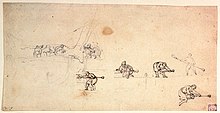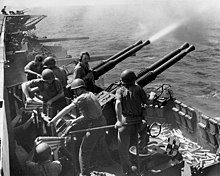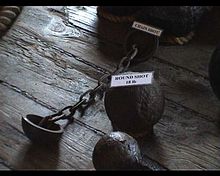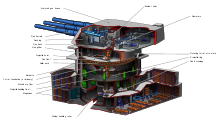Ship artillery
Naval artillery is the artillery used on board warships . It belongs to the naval artillery . For a long time, the ship's artillery consisted of muzzle loaders - smooth-barreled cannons . In the 19th century, the modern naval gun that was grenades verschießende drawn Hinterlader developed. During and after the Second World War, ship artillery lost its importance due to the development of increasingly powerful combat aircraft and the advent of guided missiles .
Development of ship artillery
Forerunner of artillery
In ancient times, rams were used on ship hulls to attack enemy ships. After the ships became larger and cumbersome over time and the ramming spur became less important, the ships began to be equipped with slingshot devices so that stone balls and arrow projectiles could be launched towards the enemy. The Byzantines developed the so-called Greek fire as a special attack weapon , which sprayed a burning liquid over a certain distance by means of a focused jet. So-called fire lances have been used on Chinese warships since their first development in the 11th century . At that time, these handguns were initially made of bamboo cane .
In spite of these weapons, sea battles were mainly fought similar to land battles; H. in infantry man-to-man combat, with the ships serving as floating combat platforms.
Ship artillery of the sailing ship era

The invention of gunpowder revolutionized ship armament and brought about a change in naval warfare. The battle was fought more and more at a distance.
In Europe , cannons had been common on ships since the 14th century . These were mainly small-caliber weapons, some breech-loading guns and also smaller Kolubrinen , which were intended more for use against the crews than against the hulls ('man-killers'). The first known use of naval guns took place in the 1340 naval battle of Sluis . At that time there were galleys that were equipped with a gun on the bow (hunting cannons); however, these ships were still intended for close combat by boarding .
The first heavier black powder guns to appear in the 15th century were bombards , which were varied and adapted to different functions over the course of the following centuries. The caliber of the cannons grew so much in the 15th century that they could also be used effectively against the opponent's wooden side walls ('ship-smashers'). In addition, there was more and more muzzle-loaders, which were cast from one piece of bronze and later iron.
Around 1500 people started installing gun ports on sailing ships along the hull, as the cannons could no longer be placed high up in the superstructure because of their higher weight. They fired through so-called gun ports in the broadside . In the beginning, the gun ports were arranged directly one above the other (for example in the case of the Great Harry galleon from 1514) - it was only in the further development of ship types that it was discovered that the so-called checkerboard arrangement of the ports offered structural and tactical advantages.

The standard type of warship had been established since the middle of the 17th century. From this point on, the sailing warship's weapon system was superior to the galleys (cf. the Candia in the naval battle of Prevesa , which was able to defend itself over a whole day against several waves of attack by enemy galleys).

By the beginning of the 17th century, the development of the muzzle-loading smooth-barreled artillery was largely complete. The ships of the line carried the majority of the guns on two or three continuous battery decks with the heaviest guns on the lowest deck. In the middle of the 17th century, according to English inventories, these were the so-called cannons, demi-cannons and culverines, which fired iron balls weighing 42, 32 and 18 pounds (19, 14.5 and 8.2 kg ). Lighter cannons stood on the upper deck. Breech loaders only existed as small calibers or as obsolete pieces.
The gun barrels were like on land with lateral trunnions on wooden Radlafetten , also called Raperts stored. The side walls of the carriage were stepped at the rear end. There the cow's foot could be inserted to ventilate the gun or a strong cross piece of wood to lay the barrel at this height. With the help of a whipstock, the angle of elevation could be changed by rotating the tube around the trunnion. The ship's carriage usually had two axles with two wide small wooden wheels each. When fired, the cannons rolled into the ship's interior due to the recoil and were caught by the Brooktau. Since the muzzle touched the edge of the gun port during this springback, the so-called ship's head was developed. This is a smooth reinforcement of the mouth, compared to the older mouth parts with many profiles, bars and flutes. The gun was then reloaded in this retrieved position. The gun was run out again through the gun ports with side talons. If there was too little time or crew to operate, the Brooktau could also be pulled taut in the run-out position. Then the gun did not roll backwards. A crew member then had to climb outboard to load the gun from there. Due to the heavy weight of the cannons, large crews were required to operate them.
By the end of the 17th century, the armament was standardized to such an extent that there was only one type of cannon on each of the continuous battery decks of the sailing warships. Now the cannons were also designated internationally according to the weight of the bullet in pounds, of course according to the regionally valid pound. In the 18th century the British Navy guns 32- 24- 18- 12- 9- 6- informed accordingly as 42-,,,,,,, 4- and 3- pounder and 0.5-pounder as swivels a. From the middle of the 18th century, all cannons were mainly cast from iron, but bronze pieces remained in use for some time. Towards the end of the 18th century, the 42-pounder were replaced by 32-pounder, as the former were too unwieldy due to their weight and heavy projectiles. The 32-pounder, which was installed in the lower decks of the ships of the line with 74 and more cannons, still weighed almost three tons and was operated by up to 14 men.
The most important type of ammunition was the solid iron bullet , which could be used against the hull, rigging and crew alike . Chain balls (two iron hemispheres connected by a short chain) or rod balls (so-called bars) (two iron balls connected by rods) were fired specifically for use against the rigging. In addition, grapeshots or hail were used against the enemy crew at short distances , for example to ward off a boarding . Although the range of the cannons was up to 2 km, the chances of hit were extremely slim beyond a few hundred meters. Around 1800, most of the commanders of the British Navy trained their gun crews to fire as quickly as possible and tried to conduct the battle from a few 10 meters away, so that shooting past was practically impossible. The combination of open fire, open gunpowder and the wooden ships with ropes and bad luck offered many opportunities to lose the ships by fire or explosion. At very short combat distances, there was a risk for both sides that the muzzle flash and the cargo plugs could catch fire first the enemy and then your own ship. The jumping back of the pipes when fired was another potential hazard on the decks overcrowded with people. The artillery of a sailing warship was usually able to penetrate the sides of a comparable enemy at short distances. Due to the small size of the cannons, however, it was difficult to sink an enemy of the same size. The effect of the cannons was directed especially when firing into the hull against the enemy armament and crew, where the majority of the losses were caused by wood splinters. The loss of masts or rigging could result in a ship being unable to maneuver. In many individual battles, i.e. in fights far away from the great sea battles, the commander of a ship was careful to be relatively careful anyway, as a boarded ship including captured crew and shipload ( prize ) brought him and his own crew a lot of prize money under certain conditions.
Carronades
In 1774, the carronade named after the Carron Iron Company was developed. Originally designed for army use, a version suitable for use on board came into use in 1779. It had a short tube and a comparatively small propellant powder charge . As a result, the projectile had a lower speed and achieved a very strong fragmentation effect on the wooden hulls. Carronades were very light - the 68-pounder carronade weighed 1.8 tons, about the same as a normal 12-pounder. So they needed a smaller crew, could be set up high in the ship and allowed heavy armament even on small ships, which could only be used at short distances (see the last battle of the USS Essex ). Carronades were mounted on sliding carriages.
mortar
At the time of sailing ships, mortars were the only guns that fired explosive projectiles as standard. They were mounted on special ships, the mortar ships, and not intended for sea battles, but for use against land targets and anchored ships. The British Navy used 13 inch and 10 inch (33 cm and 25.4 cm) mortars.
Developments in the 19th century
In the 19th century the artillery went through rapid and revolutionary developments. With the bomb cannons came the first cannons that fired explosive projectiles (= grenades) as standard. There was a race between ship armor ( armored hulls , improvement of the armor quality) and more powerful artillery. If a sailor from the time of the Spanish Armada were transferred to a ship from Nelson's time, the procedures would be almost the same and little explanation would be required. He would not find his way around on a ship at the end of the 19th century.
Technical advances made the following developments possible in particular:
- The transition to the rifled gun (around 1860) enabled more accurate shooting over a greater range. In addition, long bullets could be fired from drawn tubes instead of bullets . As a result, the weight of the projectile (and thus penetration and impact) and the firing range increased with the same caliber (in the USA, however, due to limited technical possibilities, large smooth-barreled cannons ( Dahlgren cannons ) were used until the Civil War .
- The development of the breech loader simplified the loading process. However, well into the 19th century there were considerable problems in the manufacture of the closures , especially with the gas tightness . For this reason, the British Navy used rifled muzzle loading guns up to a caliber of 16 inches until around 1880. The use of muzzle-loaders also made it easier to set up in closed towers, as the powder smoke escaped outside the tower.
- Better materials: first cast iron, then wrought iron, and then steel. This made larger guns and more powerful propellant charges possible. In a further step, the gun barrels were reinforced by one or more steel rings or blocks ( ring and jacket ring cannons).
- The introduction of slowly burning powder from 1880 onwards made even larger propellant charges possible . Since the slower burning of the propellant charge made longer gun barrels sensible, the caliber lengths increased from about L / 15 to L / 30 to L / 40. This increased the firing range , penetration power and accuracy .
- The quality of the bullets has been improved. In order to achieve a better armor-piercing effect , they were made from chilled cast iron ( Grusonwerk AG Buckau ) and then from steel from 1868 onwards. In addition, the black powder filling was supplemented by more effective explosives ( explosive shells ).
In addition, the size of the ship's guns increased in general. There was a tendency for fewer and larger guns to be installed in new ships.
The new guns required a more robust mount than before. In the middle of the 19th century, iron frame mounts were still widely used. Slide rails and rubber buffers absorbed the recoil. Finally, the barrel cradle and the hydraulic barrel return brake enabled effective mountings of even the largest guns. As a further development of the end of the 19th century came rapid-fire guns (quick-loading cannon) and machine guns (eg. T. as a revolver cannon ) added. The automatic cannons with calibers from 37-47 mm were intended for defense against torpedo boats; they soon disappeared again because of their low impact. Rapid fire guns were loaded with cartridge ammunition and had fast acting breeches. Initially used with light guns, the principle was extended to calibers up to 15.2 cm at the turn of the century and firing speeds of 5 rounds per minute were achieved with this caliber.
By improving the breeches, the loading devices and the ammunition supply, the rate of fire of the main artillery of the ships of the line could be increased to two rounds per minute in the 19th century . The designation Schnellladekanone (= Schnellfeuergeschütz ) was also transferred to these guns .
Before the Spanish-American War in 1898, around 1000 m was considered an ideal combat distance. In 1898, in the battle in the Bay of Manila and in the sea battle off Santiago de Cuba, fires were sometimes effective for several kilometers. The increased firing ranges required the introduction of formalized shooting procedures.
The modern ship artillery

By 1900 the development of ship artillery had stabilized. Ships of the line and armored cruisers normally had a three-part artillery made up of rapid-loading cannons (from the point of view of the barrel construction, they were still tubulars):
- Two to four (sometimes more at armored cruisers) guns of the main artillery, usually in turrets arranged. The caliber of ships of the line was mostly 30.5 cm, and armored cruisers mostly 20.3 to 25.4 cm.
- A middle artillery set up on the sides of the ship in casemates or towers to support the main artillery with a caliber of 15.2 cm.
- A light artillery set up freely behind shields or in casemates in the available spaces to defend against torpedo boats with a caliber of 37 mm to 8.8 cm.
Protected cruisers mostly carried guns of 10.2 to 15.2 cm caliber as their main armament, individually positioned behind shields or in casemates.
The dreadnought revolution brought a reinforcement of the main artillery and partly the elimination of the middle artillery. At the latest with the First World War it became clear that the light artillery was too easy to defend against torpedo boats. It was partially replaced by the first anti-aircraft guns.
During the First World War, the caliber of the main artillery of the ships of the line grew to 40.6 cm, which, with two exceptions ( HMS Furious and Yamato class ), was not exceeded until the end of the heavy artillery era. From the beginning of the 1920s on newly built battleships and cruisers, the guns installed in casemates and, with the exception of anti-aircraft guns, behind individual shields largely disappeared .
The guns of the First World War allowed combat distances of 10–20 km, which made a corresponding fire control necessary. The necessary procedures and devices ( fire control system , range finder ) were developed before the First World War. Known and measured data (own course, own speed, direction of the target, distance to the target) were combined with estimated (course and speed of the target) in mechanical calculating machines and the orientation determined in this way was passed on to the guns. To correct this, the position of the markups was assessed and included in the estimate. In the Second World War, the fire control was again decisively improved through the use of radar. From the mid-1920s, battleships and cruisers mostly carried on-board aircraft to monitor the hit position and to shoot over the horizon .
Towards the end of the Second World War, the development of fully automatic guns in caliber 15.2 cm and 20.3 cm for cruisers (British Tiger class , US Worcester class , Des Moines class ) began, but due to the Missile development has not long been used.
Flak

During the First World War, the first anti-aircraft guns ( flak or flak for short ) were installed on ships. From the 1920s, warships were generally given anti-aircraft guns. At the beginning of the Second World War, battleships, aircraft carriers and cruisers generally carried heavy flak (caliber 7.5–13 cm), automatic cannons in caliber 20–40 mm (sometimes only semi-automatic) and anti-aircraft machine guns . The role of the heavy flak was partly taken over by multi-purpose guns of the middle artillery . MGs were partly displaced by the 20 mm gun from Oerlikon due to their low effectiveness in the war . In the case of the heavy and medium (37 mm, 40 mm) flak, it was found that the effectiveness was crucially dependent on the quality of the fire control. Towards the end of the war, the US Navy had effective radar fire control for its 12.7 cm and 40 mm flak.
present
Today most warships use cannons up to 15.5 cm caliber, which have an automatic loading device and whose range depends on the type of ammunition used . Guns are used for close-range defense against boats , aircraft and missiles or for coastal fire. Modern marine artillery is often too small in caliber for the latter purpose, which is why the US Navy kept two Iowa-class battleships in service until 2006.
Due to changing operational conditions (including asymmetric warfare , peacekeeping operations , amphibious warfare ), land target shelling is gaining new importance as a tactical fire support . In Germany it was therefore examined to what extent the gun turret of the self-propelled howitzer 2000 could be navalized ( MONARC project ). After the project was discontinued, the Oto Melara 127/64 Lightweight was chosen as the ship artillery for the new frigates of the Baden-Württemberg class (F125) , with which the precision-guided Vulcano ammunition can be fired, which can reach ranges of 70 to 100 km. The 127/64 Lightweight with the Vulcano ammunition is also used in the land attack version of the Italian FREMM frigates . The US Army is pursuing similar goals with the development of the Advanced Gun System for the planned destroyers of the Zumwalt class , which will have a caliber of 155 mm and also range-increased precision ammunition.
Historical significance of the cannon as a ship artillery
The development of the cannon and its perfecting in Europe ultimately contributed decisively to the fact that European states, even if they were outnumbered, were able to prevail against attempts at annexation by other peoples and militaries from other continents.
Europeans quickly found that light, mobile guns offer tactical advantages, as they can be aimed quickly and allowed a significantly higher rate of fire . Especially on the water, i.e. on warships , it quickly became apparent that a single ship equipped with light cannons could successfully fight a superior force without suffering excessive damage. This was then also a major success for Europe, on the one hand to defend itself against the influences of Asian expansion attempts and on the other hand to enforce its own expansion and colonization interests.
In 1502 Vasco da Gama set sail for his second voyage to India. The ships were equipped with the most modern ship artillery of the time, as an armed conflict with the Arabs was expected. Once in Indian waters, he was attacked by around 100 vehicles from an Arab-Indian fleet. With the artillery of 15 of his ships he was able to thwart all boarding attempts. The artillery spurred the Age of Discovery (= "Age of European Expansion").
So it is obvious why Spain and Portugal - and later also the Netherlands, France and England - succeeded in gaining a foothold on other continents and exercising corresponding influences there: They equipped pot-bellied merchant and warships with an appropriate number of cannons and were thus able to secure hegemony in Europe and at the same time their colonial interests.
See also
- Field snake , stone rifle , kartaune , artillery , gunboat , cannonball , ballista , catapult . Gun .
- Railgun
literature
- Douglas, Buchardi: Treatise on ship artillery. Carl Schröder & Comp., Kiel 1850.
- Paul Schmalenbach: The history of the German ship artillery. Koehlers Verlagsgesellschaft, Hamburg 1968, ISBN 3-7822-0577-4 .
- Ulrich Israel, Jürgen Gebauer: Warships in the 19th century. Gondrom-Verlag, Bindlach 1989, ISBN 3-8112-0626-5 .
- Ulrich Israel, Jürgen Gebauer: Armored ships around 1900. Brandenburg publishing house, ISBN 3-89488-027-9 .
- Jane's Battleships of the 20th Century. HarperCollins Publishers, London 1996, ISBN 0-00-470997-7 .
- Carlo M. Cipolla: Sails and Cannons - The European Expansion at Sea. Verlag Klaus Wagenbach, Berlin 1999, ISBN 3-8031-3602-4 .
- Wolfram zu Mondfeld: Historical ship models. (Special edition), Orbis Verlag, Munich 2003, ISBN 3-572-01464-6 .
- Scott Robertson: Basic knowledge of ship model building. Verlag für Technik und Handwerk, Baden-Baden 2004, ISBN 3-88180-733-0 .
- Klaus Krick: self-built historical ship models. Neckar Verlag, Villingen-Schwenningen 2003, ISBN 3-7883-3136-4 .
Web links
- Page with descriptions of naval guns (English)
Individual evidence
- ↑ Frank Howard: Sailing Warships 1400-1860. 2nd Edition. Bernard & Graefe Verlag, Koblenz 1989, ISBN 3-7637-5239-0 , p. 38.
- ↑ Frank Howard: Sailing Warships 1400-1860. 2nd Edition. Bernard & Graefe Verlag, Koblenz 1989, ISBN 3-7637-5239-0 , p. 72f.
- ↑ Frank Howard: Sailing Warships 1400-1860. 2nd Edition. Bernard & Graefe Verlag, Koblenz 1989, ISBN 3-7637-5239-0 , p. 145.
- ↑ In Eduard Bobrik the action sequences and commands given to load a ship gun
- ↑ Frank Howard: Sailing Warships 1400-1860. 2nd Edition. Bernard & Graefe Verlag, Koblenz 1989, ISBN 3-7637-5239-0 , p. 207.
- ↑ Frank Howard: Sailing Warships 1400-1860. 2nd Edition. Bernard & Graefe Verlag, Koblenz 1989, ISBN 3-7637-5239-0 , p. 208.
- ↑ Frank Howard: Sailing Warships 1400-1860. 2nd Edition. Bernard & Graefe Verlag, Koblenz 1989, ISBN 3-7637-5239-0 , p. 210f.
- ^ A b c d Carlo M. Cipolla: Sails and cannons - The European expansion at sea. Verlag Klaus Wagenbach, Berlin 1990, ISBN 3-8031-3602-4 .









